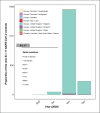SARS-CoV-2 Lineages and Sub-Lineages Circulating Worldwide: A Dynamic Overview
- PMID: 33735881
- PMCID: PMC8089399
- DOI: 10.1159/000515340
SARS-CoV-2 Lineages and Sub-Lineages Circulating Worldwide: A Dynamic Overview
Abstract
Severe acute respiratory syndrome coronavirus 2 (SARS-CoV-2) originated in Wuhan, China, in early December 2019 has rapidly widespread worldwide, becoming one of the major global public health issues of the last centuries. Key Messages: Over the course of the pandemic, due to the advanced whole-genome sequencing technologies, an unprecedented amount of genomes have been generated, providing invaluable insights into the ongoing evolution and epidemiology of the virus during the pandemic. Therefore, this large amount of data played an important role in the SARS-CoV-2 mitigation and control strategies. Key Messages: The active monitoring and characterization of the SARS-CoV-2 lineages circulating worldwide is useful for a more specific diagnosis, better care, and timely treatment. In this review, a concise characterization of all the lineages and sub-lineages circulating and co-circulating across the world has been presented in order to determine the magnitude of the SARS-CoV-2 threat and to better understand the virus genetic diversity and its dispersion dynamics.
Keywords: Genome diversity; Lineages; Pandemic; Prevention strategies; SARS-CoV-2.
© 2021 S. Karger AG, Basel.
Conflict of interest statement
The authors have no conflicts of interest to declare.
Figures


References
-
- Gorbalenya AE, Baker SC, Baric RS, de Groot RJ, Drosten C, Gulyaeva AA, et al. Severe acute respiratory syndrome-related coronavirus: the species and its viruses: a statement of the Coronavirus Study Group. bioRxiv. 2020 Feb
-
- WHO WHO Director-General's remarks at the media briefing on 2019-nCoV on 11 February 2020 [Internet] [cited 2020 Dec 14]. Available from: https://www.who.int/director-general/speeches/detail/who-director-genera....
Publication types
MeSH terms
LinkOut - more resources
Full Text Sources
Other Literature Sources
Medical
Miscellaneous
